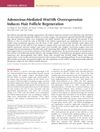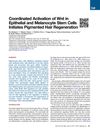Activated Hair Follicle Stem Cells and Wnt/β-Catenin Signaling Involved in Pathogenesis of Sebaceous Neoplasms
January 2014
in “
International Journal of Medical Sciences
”

TLDR Abnormal activation of hair follicle stem cells and Wnt/β-catenin signaling contributes to sebaceous neoplasms.
The study investigated the role of hair follicle stem cells (HFSCs) and Wnt/β-catenin signaling in the development of sebaceous neoplasms. Using DMBA and TPA treatments, researchers identified sebaceous neoplasms and analyzed them through staining techniques. They found that HFSCs, marked by SOX-9 and CD34, were present and active in the basal layer of sebaceous lobules within the neoplasms. Additionally, Wnt10b/β-catenin signaling was activated in these cells. The findings suggested that the abnormal activation of HFSCs and Wnt10b/β-catenin signaling played a role in the pathogenesis of sebaceous neoplasms.



